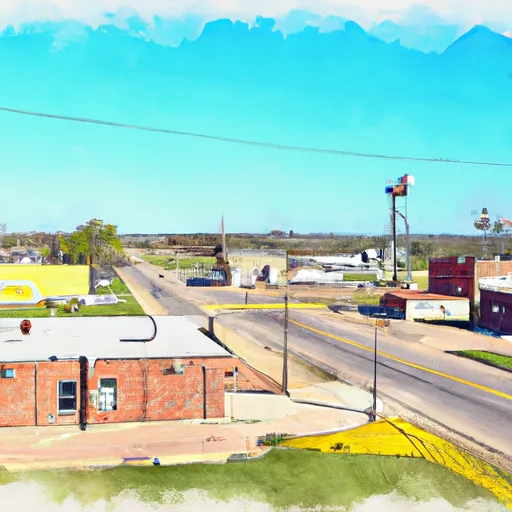-
 Snoflo Premium
Snoflo Premium
Get unlimited access to all our content
With no Ad interruptions! - Start Your Free Trial Login with existing account
Jay
Eden Index
Climate
8.2
•
Recreation
2.3
•
Community
1.6
•
Safeguard
4.5/10

Jay, Oklahoma is a small town located in the northeastern part of the state. The climate in Jay can be described as humid subtropical, characterized by hot summers and mild winters. Average temperatures range from around 30°F (-1°C) in January to approximately 90°F (32°C) in July. Precipitation is fairly evenly distributed throughout the year, with an average annual rainfall of about 50 inches (127 cm).
Hydrologically, Jay is situated near the Illinois River, which flows through the region. This river is known for its clear, cool waters and is popular among outdoor enthusiasts for activities such as canoeing, kayaking, and fishing. It is also home to a variety of aquatic wildlife, including smallmouth bass and catfish.
In addition to the Illinois River, Jay and the surrounding area offer several outdoor recreation opportunities. Outdoor enthusiasts can enjoy hiking and camping in nearby natural areas such as the Cherokee State Park, which features scenic trails and picturesque picnic spots. The town also has parks and recreational facilities that provide space for activities like sports, walking, and family gatherings. Overall, Jay, Oklahoma provides a great environment for enjoying nature and various outdoor pursuits.
What is the Eden Index?
The Snoflo Eden Index serves as a comprehensive rating system for regions, evaluating their desirability through a holistic assessment of climate health, outdoor recreation opportunities, and natural disaster risk, acknowledging the profound impact of these factors on livability and well-being.
Climate Health Indicator (CHI): 8.2
Jay receives approximately
1157mm of rain per year,
with humidity levels near 81%
and air temperatures averaging around
15°C.
Jay has a plant hardyness factor of
7, meaning
plants and agriculture in this region tend to thrive during the non-winter months.
By considering the ideal temperature range, reliable water supplies, clean air, and stable seasonal rain or snowpacks, the Climate Health Indicator (CHI) underscores the significance of a healthy climate as the foundation for quality living.
A healthy climate is paramount for ensuring a high quality of life and livability in a region, fostering both physical well-being and environmental harmony. This can be characterized by ideal temperatures, reliable access to water supplies, clean air, and consistent seasonal rain or snowpacks.
Weather Forecast
Streamflow Conditions
Neosho
Area Rivers
Neosho
Snowpack Depths
Neosho
Reservoir Storage Capacity
Neosho
Groundwater Levels
Recreational Opportunity Index (ROI): 2.3
The Recreational Opportunity Index (ROI) recognizes the value of outdoor recreational options, such as parks, hiking trails, camping sites, and fishing spots, while acknowledging that climate plays a pivotal role in ensuring the comfort and consistency of these experiences.
Access to outdoor recreational opportunities, encompassing activities such as parks, hiking, camping, and fishing, is crucial for overall well-being, and the climate plays a pivotal role in enabling and enhancing these experiences, ensuring that individuals can engage in nature-based activities comfortably and consistently.
Camping Areas
| Campground | Campsites | Reservations | Toilets | Showers | Elevation |
|---|---|---|---|---|---|
| Beavers Bend State Park | None | 460 ft | |||
| Talimena State Park | None | 1,064 ft | |||
| Wards Landing - Lake Wister State Park | None | 519 ft | |||
| Winding Stair | 23 | 1,961 ft | |||
| Victor Area - Lake Wister State Park | None | 506 ft | |||
| Below the Dam - Lake Wister State Park | None | 462 ft | |||
| Applegate Cove - Kerr Reservoir | None | 481 ft | |||
| Quarry Island - Lake Wister State Park | None | 523 ft | |||
| Billy Creek | 12 | 836 ft | |||
| Hochatown State Park | None | 640 ft |
Nearby Fishing
Catastrophe Safeguard Index (CSI):
The Catastrophe Safeguard Index (CSI) recognizes that natural disaster risk, encompassing floods, fires, hurricanes, and tornadoes, can drastically affect safety and the overall appeal of an area.
The level of natural disaster risk in a region significantly affects safety and the overall livability, with climate change amplifying these risks by potentially increasing the frequency and intensity of events like floods, fires, hurricanes, and tornadoes, thereby posing substantial challenges to community resilience and well-being.
Community Resilience Indicator (CRI): 1.6
The Community Resilience Indicator (CRI) recognizes that education, healthcare, and socioeconomics are crucial to the well-being of a region. The CRI acknowledges the profound impact of these elements on residents' overall quality of life. By evaluating educational resources, healthcare accessibility, and economic inclusivity, the index captures the essential aspects that contribute to a thriving community, fostering resident satisfaction, equity, and social cohesion.

